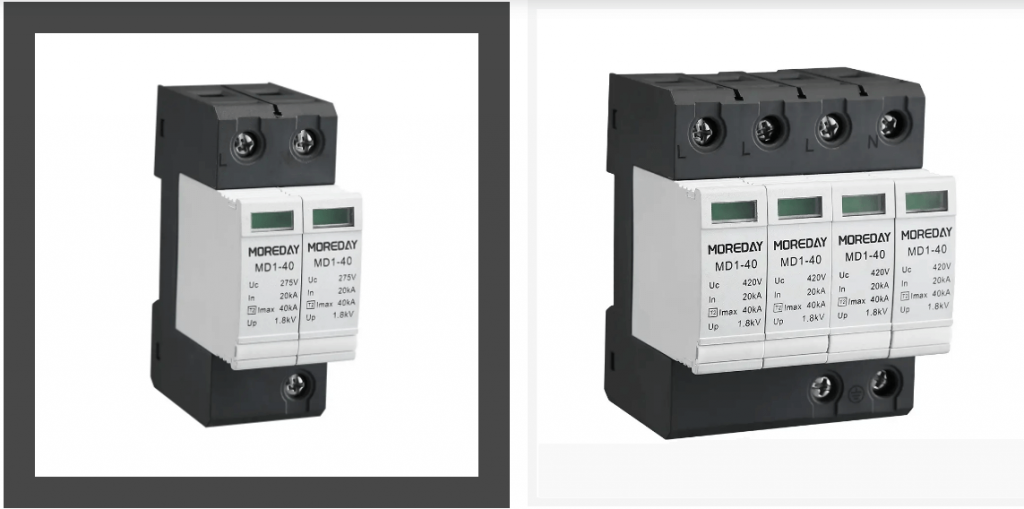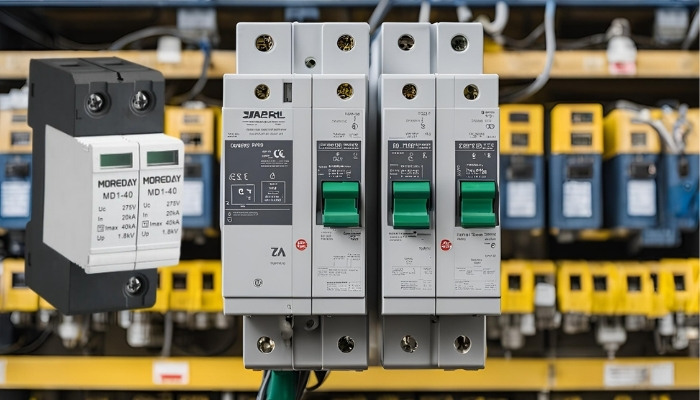Type 2 surge protection devices (SPDs) are devices that protect electrical systems from voltage spikes caused by lightning strikes or power grid fluctuations.
Installed in residential or commercial electrical distribution panels, these devices effectively prevent surges that can damage sensitive electronic equipment and infrastructure.
In this introduction, we will take a closer look at the details of Type 2 surge protectors, their operating mechanisms, and the critical role they play in maintaining the integrity and functionality of electrical systems.
What is a Type 2 SPD?

A Type 2 surge protection device is a protective device installed in an electrical distribution system to prevent equipment damage caused by transient overvoltages in the power grid. Usually, it is installed in a distribution box in a building to shunt and suppress current.
A Type 2 SPD is an intermediate level of protection in a surge protection system. It is usually used as the second line of defense after Type 1 SPD (main distribution protection). It can effectively reduce the impact of surges that are not fully suppressed in the main distribution box on subsequent equipment.
Advantages of Type 2 SPDs
Type 2 SPDs have several advantages that make them an indispensable component for protecting electrical systems:
- Effective protection: They can effectively protect electrical systems from voltage surges caused by indirect effects of lightning strikes or grid problems, reducing equipment failures and extending equipment life.
- Enhanced safety: They help prevent the risk of fires caused by voltage surges and improve the overall electrical safety of residential and commercial buildings.
- Economical: By reducing the cost of repairing and replacing equipment, Type 2 SPDs can save users a lot of maintenance costs in the long run.
- Easy to install: They are usually installed in distribution boards and are compatible with existing electrical systems, making the installation process simple and quick.
- Wide application: They are suitable for various residential, commercial, and industrial environments, with high flexibility to meet the needs of different occasions.
- Standardized products: Most Type 2 SPDs comply with international electrical standards, such as IEC 61643-11, and users can choose the right product according to their specific needs.
These advantages prove that Type 2 SPDs are an effective solution to help mitigate the impact of high voltage surges that electrical systems may suffer and ensure the normal operation and safety of equipment.
Working Principle of Type 2 Surge Protector
The working principle of Type 2 surge protectors is to use components such as built-in varistors or gas discharge tubes to quickly reduce their impedance when transient overvoltages occur (such as lightning strikes or switching operations in power systems), allowing excessive current to be diverted from the circuit to ground.
The Type 2 SPD is usually connected to the phase line (L), neutral line (N), and ground line (PE) of the distribution line. By absorbing or conducting transient high voltage, the voltage amplitude is limited to a safe range to avoid damage to the equipment.
The Type 2 surge protector has a faster response time. Once it detects that the current exceeds the normal range, it will start and complete the shunting of the surge voltage in just a few nanoseconds.
This feature ensures that the Type 2 SPD can quickly respond to transient voltage changes in the power grid and prevent the equipment from being affected by current fluctuations.
Application of Type 2 SPD
Type 2 SPD is mainly used to provide overvoltage protection for electrical systems. Specific applications include:
1. Home and Commercial Places
Type 2 SPD is commonly used in homes and small and medium-sized commercial buildings to protect sensitive equipment such as computers, televisions, and household appliances.
It can effectively deal with voltage shocks caused by lightning or power fluctuations, especially when installed in high-frequency distribution boxes, it can well protect the electrical safety of equipment.
2. Industrial Facilities and Data Centers
In large industrial facilities, Type 2 SPD is also widely used for distributed electrical equipment protection. For highly sensitive equipment such as data centers and telecommunications base stations, Type 2 SPD can provide effective intermediate protection to avoid electrical damage caused by high-power motor startup, power grid fluctuations, etc.
3. Special Environments (Such as Medical Equipment)
For medical places, Type 2 SPD can protect the electrical stability of operating rooms, intensive care units, and other medical equipment areas. Such equipment is very sensitive to voltage fluctuations, and installing a Type 2 SPD can reduce the risk of abnormal current on equipment operation.
Differences From Other Types of Surge Protectors

There are different types of surge protection devices. Let’s take a look at the differences between type 2 and type 1 and 3 surge protectors:
1. Type 1 Surge Protector
The Type 1 SPD is usually installed in the main distribution box, mainly used to resist instantaneous high voltage caused by direct lightning strikes or high-energy surges, and has a large current capacity.
Type 1 Surge Protector is mainly for surge protection of the main power grid. Unlike Type 1, Type 2 Surge Protector is mainly used to reduce the residual voltage after primary protection to ensure the safety of distribution equipment and terminal equipment.
2. Type 3 Surge Protector
The Type 3 surge protector is usually installed directly near the equipment terminal or socket to prevent low-energy surges in the final stage.
The Type 3 SPD is mainly used to protect precision electrical equipment from tiny surges. The Type 2 surge protector is installed in the distribution box, providing higher energy tolerance, stronger tolerance, and intermediate protection functions.
How to Choose a Type 2 SPD?
When you decide to buy a Type 2 SPD, you need to consider the following key factors:
1. Surge Discharge Capacity
When choosing a Type 2 SPD, pay special attention to its surge discharge capacity (e.g. kA value). Generally, the Type 2 SPD capacity for homes or small commercial buildings is in the range of 20-40kA, while industrial sites are recommended to choose devices above 40kA to cope with higher current requirements.
2. Response Time
The response time of a Type 2 SPD is usually in the nanosecond range. The shorter the response time, the stronger the adaptability to instantaneous voltage changes. When purchasing, choosing a Type 2 SPD with a fast response speed can further improve the surge protection effect.
3. Quality Certification and Standards
A high-quality Type 2 SPD should comply with international certification standards such as IEC 61643-11 or UL 1449 to ensure its reliable quality.
Choosing a certified product not only guarantees its performance but also means that the product is more stable and has a longer life in terms of withstanding surges.
4. Installation Location and Method
The installation location and method of the Type 2 SPD also affect its protection effect. It is usually installed on each branch circuit in the distribution box to ensure the protection of the main load.
When purchasing, it is recommended to choose the appropriate SPD type and specification according to the installation location.
Maintenance and Testing Methods for Type 2 Surge Protectors
1. Regularly Check the Status Indicator Light
Most Type 2 SPDs are equipped with a status indicator light, which is green when operating normally.
If the indicator light is red or off, it means that the SPD may have failed or reached the replacement period, and needs to be replaced in time to ensure the safety of the electrical system.
2. Surge Event Recording
Some advanced Type 2 SPD devices have a surge event recording function that can record the number and intensity of surges to help users understand the surge risks of the electrical system and take preventive measures in time.
3. Regular Testing and Maintenance
It is recommended to test the Type 2 surge protector every 6-12 months, especially during thunderstorms, when the equipment frequently trips, or after a surge event in the system.
Use a multimeter or professional tester to check the input and output voltages of the SPD to ensure that it performs normally.
Conclusion
Type 2 surge protectors can provide effective intermediate protection in electrical systems to prevent electrical equipment from being damaged when encountering surges. Through regular maintenance and correct selection, Type 2 surge protectors can significantly improve system reliability and equipment life.
Selecting the correct SPD model, regularly checking the status of the surge protector, and understanding its working principle and application scenarios are the keys to ensuring the normal operation and protection effect of the surge protector.
To purchase surge protectors, please visit MOREDAY’s website. Their products use advanced technology to ensure excellent and reliable overvoltage protection for your electrical equipment.
FAQ
1. Do I need other protection after installing the Type 2 SPD?
Yes, after installing the Type 2 SPD, the primary and tertiary SPDs still need to be installed according to the needs of the electrical system, because the Type 2 SPD is mainly used for intermediate protection in the distribution box, and cannot completely replace the entire surge protection system.
2. Are the Type 2 SPD models the same for all locations?
The models of Type 2 SPDs (surge protectors) are not the same. The current demand and surge tolerance in different locations are different. The Type 2 surge protector should be selected according to the actual current load and surge risk to ensure that it meets the specific needs of the location.
Although the basic function of the Type 2 SPD is similar, that is, to protect the electrical system from voltage surges, the specific model and specifications need to be selected according to the specific conditions of the installation site. Doing so not only ensures the safe operation of the equipment but also improves the overall efficiency and stability of the system.
3. Can the Type 2 SPD be used indefinitely?
Type 2 SPDs (surge protectors) cannot be used indefinitely. Their efficiency and life are affected by multiple surge events, and they need to be replaced once the absorption capacity limit is reached.
In addition, environmental factors and the frequency of electrical shocks can also affect their durability, so they need to be regularly inspected and replaced as appropriate to ensure that they continue to effectively protect the electrical system.
Related reading: How to test a circuit breaker


